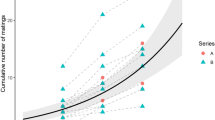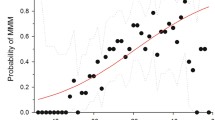Abstract
Courtship and body condition of male two-spotted gobies (Gobiusculus flavescens) harbouring naturally acquired microsporidian infections were compared with those of microsporidian-free males under standardized conditions in the lab. Although parasite infection had no apparent effect on individual condition, it significantly affected male courtship intensity. This effect, however, was affected by the intensity of the female courtship. Our study is one of the first to demonstrate a sub-lethal behavioural effect of a microsporidian parasite that could negatively affect the reproductive success of infected individuals. Our results also suggest that secondary sexual traits like courtship may be more sensitive to moderately detrimental effects of parasite infection than classical condition indices.



Similar content being viewed by others
References
Amundsen T, Forsgren E (2001) Male mate choice selects for female coloration in a fish. Proc Natl Acad Sci USA 98:13155–13160
Amundsen T, Forsgren E (2003) Male preference for colourful females affected by male size in a marine fish. Behav Ecol Sociobiol 54:55–64
Andersson M (1994) Sexual selection. Princeton University Press, New Jersey
Arnott SA, Barber I, Huntingford FA (2000) Parasite-associated growth enhancement in a fish-cestode system. Proc R Soc Lond B 267:657–663
Barber I, Hoare D, Krause J (2000) Effects of parasites on fish behaviour: a review and evolutionary perspective. Rev Fish Biol Fisher 10:131–165
Bjelvenmark J, Forsgren E (2003) Effects of mate attraction and male–male competition on parental care in a goby. Behaviour 140:55–69
Borgia G, Egeth M, Uy JA, Patricelli GL (2004) Juvenile infection and male display: testing the bright male hypothesis across individual life histories. Behav Ecol 15:722–728
Brønseth T, Folstad I (1997) The effect of parasites on courtship dance in threespine sticklebacks: more than meets the eye? Can J Zool 75:589–594
Bush AO, Fernández JC, Esch GW, Seed JR (2001) Parasitism: the diversity and ecology of animal parasites. Cambridge University Press, Cambridge
Candolin U (2000) Increased signalling effort when survival prospects decrease: male–male competition ensures honesty. Anim Behav 60:417–422
Chellappa S, Huntingford FA, Strang RHC, Thompson RY (1995) Condition factor and hepatosomatic index as estimates of energy status in male three-spined stickleback. J Fish Biol 47:775–787
Dugatkin LA, Fitzgerald GJ, Lavoie J (1994) Juvenile three-spined sticklebacks avoid parasitized conspecifics. Environ Biol Fishes 39:215–218
Dunn AM, Smith JE (2001) Micropsoridian life cycles and diversity: the relationship between virulence and transmission. Microb Infect 3:381–388
Figueras A, Novoa B, Santarem M, Martinez E, Alvarez JM, Toranzo AE, Dykova I (1992) Tetramicra brevifilum, a potential threat to farmed turbot Scophtalmus maximus. Dis Aquat Org 14:127–135
Folstad I, Karter AJ (1992) Parasites, bright males, and the immunocompetence handicap. Am Nat 139:603–622
Forbes MRL (1993) Parasitism and host reproductive effort. Oikos 67:444–450
Forsgren E (1997) Mate sampling in a population of sand gobies. Anim Behav 53:267–276
Forsgren E, Amundsen T, Borg AA, Bjelvenmark J (2004) Unusually dynamic sex roles in a fish. Nature 429:551–554
Gordon JCD (1983) Some notes on small kelp forest fish collected from Saccorhiza polyschides bulbs on the Isle of Cumbrae Scotland. Ophelia 22:173–183
Hamilton WD, Zuk M (1982) Heritable true fitness and bright birds: a role for parasites? Science 218:384–387
Houde AE, Torio AJ (1992) Effect of parasitic infection on male color pattern and female choice in guppies. Behav Ecol 3:346–351
Hurd H (2001) Host fecundity reduction: a strategy for damage limitation? Trends Parasitol 17:363–368
Kennedy CEJ, Endler JA, Poynton SL, McMinn H (1987) Parasite load predicts mate choice in guppies. Behav Ecol Sociobiol 21:291–295
Kotiaho JS (2002) Sexual selection and condition dependence of courtship display in three species of horned dung beetles. Behav Ecol 13:791–799
Lom J, Dyková I (1992) Protozoan parasites of fishes, vol 26. Dev Aquacult Fish, Elsevier, Amsterdam
Lom J, Nilsen F (2003) Fish microsporidia: fine structure diversity and phylogeny. Int J Parasitol 33:107–127
Lopez S (1999) Parasitized female guppies do not prefer showy males. Anim Behav 57:1129–1134
Marcogliese DJ, Dumont P, Gendron AD, Mailhot Y, Bergeron E, McLaughlin JD (2001) Spatial and temporal variation in abundance of Diplostomumspp. in walleye (Stizostedion vitreum) and white suckers (Castostomus commersoni) from the St. Lawrence River. Can J Zool 79:355–369
Matthews JL, Brown AMV, Larison K, Bishop-Stewart JK, Rogers P, Kent ML (2001) Pseudoloma neurophilia n.g. sp., a new microsporidium from the central nervous system of the zebrafish (Danio rerio). J Eukaryot Microbiol 48:227–233
Milinski M (1990) Parasites and host decision-making. In: Barnard CJ, Behnke JM (eds) Parasitism and Host Behaviour. Taylor and Francis, London, pp 95–116
Milinski M, Bakker TCM (1990) Female sticklebacks use male coloration in mate choice and hence avoid parasitized males. Nature 344:330–333
Miller PJ (1986) Gobiidae. In: Whitehaed PJP, Bauchot ML, Hureau JC, Nielsen J, Tortonese E (eds) Fishes of North-eastern Atlantic and the Mediterranean, vol III. Bungay UNESCO, pp 1019–1085
Minchella DJ, Scott ME (1991) Parasitism: a cryptic determinant of animal community structure. Trends Ecol Evol 6:250–254
Pélabon C, Borg ÅA, Bjelvenmark J, Forsgren E, Barber I, Amundsen T (2003) Do male two-spotted gobies prefer large and fecund females? Behav Ecol 14:787–792
Petersen CW (1995) Male mating success and female choice in permanently territorial damselfishes. Bull Mar Sci 57:690–704
Polak M, Starmer WT (1998) Parasite-induced risk of mortality elevates reproductive effort in male Drosophila. Proc R Soc Lond B 265:2197–2201
Poulin R (1994) Mate choice decisions by parasitized female upland bullies, Gobiomorphus breviceps. Proc R Soc Lond B 256:183–187
Poulin R (1999) The functional importance of parasites in animal communities: many roles at many levels? Int J Parasitol 29:903–914
Poulin R, Vickery WL (1996) Parasite mediated sexual selection: just how choosy are parasitized females? Behav Ecol Sociobiol 38:43–49
Reynolds JD (1993) Should attractive individuals court more? Theory and a test. Am Nat 141:914–927
Rosenqvist G, Johansson K (1995) Male avoidance of parasitized females explained by direct benefits in a pipefish. Anim Behav 49:1039–1045
Santos MJ, Eiras JC (1995) A seasonal study of the parasitization of Lipophrys pholis (Pisces: blenniidae) by Heliocometra fasciata (Digenea: Opecoelidae) and Lecithochirium furcolabiatum (Digenea: Hemiuridae) in Portugal. Aquaculture 132:175–181
Skolbekken R, Utne-Palm AC (2001) Parental investment of male two-spotted goby, Gobiusculus flavescens (Fabricius). J Exp Mar Biol 261:137–157
Swensson RO (1997) Sex-role reversal in the tidewater goby, Eucyclogobius newberryi. Environ Biol Fish 50:27–40
Takahashi D (2000) Conventional sex roles in an amphidromous Rhinogobius goby in which females exhibit nuptial coloration. Ichthyol Res 47:303–306
Thompson CW, Hillgarth N, Leu M, McClure HE (1997) High parasite load in house finches (Carpodacus mexicanus) is correlated with reduced expression of a sexually selected trait. Am Nat 149:270–294
Venables WN, Ripley BD (2002) Modern applied statistics with S-plus. Springer, Berlin, Heidelberg, New York
Williams GC (1966) Natural selection, the costs of reproduction and a refinement of Lack’s principle. Am Nat 100:687–690
Zuk M, Kim T, Robinson SI, Johnsen TS (1998) Parasites influence social rank and morphology, but not mate choice, in female red junglefowl, Gallus gallus. Anim Behav 56:493–499
Acknowledgements
We thank Katja Norén for help during field work, Nigel G. Yoccoz and Ivar Herfindal for discussion on statistical issues, and Angela Russell for help in identifying the parasite. We also thank the two anonymous reviewers for their constructive comments. This study was carried out according to the legislation on animal rights of Sweden and following the research application to the Swedish ethical committee (ref # 51/99). The study was financially supported by the MARE program of the Research Council of Norway, the EU Transnational Access to Research Infrastructures programme, the Swedish Natural Sciences Research Council, the Swedish King Carl XVI Gustaf’s anniversary fund, the Norwegian Academy of Science and the UK Natural Environment Research Council.
Author information
Authors and Affiliations
Corresponding author
Additional information
Communicated by M. Kühl, Helsingør
Rights and permissions
About this article
Cite this article
Pélabon, C., Borg, Å.A., Bjelvenmark, J. et al. Do microsporidian parasites affect courtship in two-spotted gobies?. Marine Biology 148, 189–196 (2005). https://doi.org/10.1007/s00227-005-0056-8
Received:
Accepted:
Published:
Issue Date:
DOI: https://doi.org/10.1007/s00227-005-0056-8




